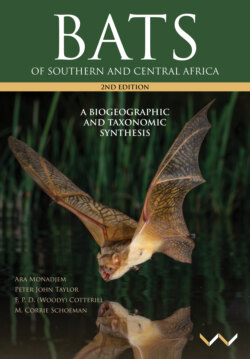Читать книгу Bats of Southern and Central Africa - Ara Monadjem - Страница 16
На сайте Литреса книга снята с продажи.
CHIROPTERA COLLECTIONS
ОглавлениеThe devotion of bat collectors in southern Africa has led to the establishment of several major Chiroptera collections, housed in the following southern African museums: the Amathole Museum (previously the Kaffrarian Museum, King Williams' Town), the Durban Natural Science Museum, the National Museum (Bloemfontein), the South African Museum (Cape Town), the Ditsong National Museum of Natural History (formerly the Transvaal Museum, Pretoria), the Natural History Museum of Zimbabwe (Bulawayo), and the Namibian National Museum (Windhoek). There are smaller mammal collections in Angola (Lubango and Dundo), Zambia (Livingstone), Malawi (Blantyre), Mozambique (Maputo), and more recently in the E. O. Wilson Laboratory in Gorongosa National Park (Chitengo, Mozambique) and at the University of Eswatini (Kwaluseni, Eswatini). These important resources, located within Africa, complement the major natural history museums in Europe and North America (see the List of Specimens).
Figure 6. Senior Technical Officer Alick Ndlovu, Natural History Museum of Zimbabwe (NMZB), collating field data on bat specimens in western Zambia in November 1998. Alick Ndlovu deserves special credit for his sterling efforts in re-cataloguing the entire Mammal Collection (NMZB), which includes nearly 9,000 specimens of Chiroptera (© F. P. D. Cotterill).
Figure 7. (a) Prototype of a bicycle trap placed under a crevice roost ~100 m up a granite precipice; the trap is suspended from pulleys secured on the inselberg summit (Cotterill and Fergusson 1993). (b) Three species of free-tailed bats captured from their crevice roost using a bicycle trap near Chikupu Caves, including Chaerephon ansorgei and C. bivittatus, with a Tadarida fulminans in the foreground (Murigabveni, northeast Zimbabwe; © F. P. D. Cotterill).
Figure 8. (a) A harp trap set in a path through forest understory, near Sakeji School, northwest Zambia. (b) Detail of the three banks of nylon lines that intercept flying bats. This design was modified from that of Tidemann and Woodside (1978) (© F. P. D. Cotterill).
Figure 9. Harp trap set over a side channel of the Limpopo River (© F. P. D. Cotterill).
Figure 10. (a) Macronet (30 × 6 m) awaiting nocturnal fieldwork (Chivi District, southern Zimbabwe). The modified 8 m yacht masts are held erect by guy ropes. (b) Detail of the net links and pulley system that facilitates rapid access to netted bats (© F. P. D. Cotterill).
The following European and North American museums hold significant collections from Africa (including its southern and central regions): the American Museum of Natural History (New York, AMNH), the California Academy of Sciences Natural History Museum (San Francisco, CalaCAD), the Carnegie Museum of Natural History (Pittsburgh, CMNH), the Field Museum of Natural History (Chicago, FMNH), the Harrison Zoological Museum (Sevenoaks, HZM), the Los Angeles County Museum (LACM), the Museum Alexander Koenig (Bonn, ZFMK), the Museum of Comparative Zoology (Harvard, MCZ), the von Humboldt Museum of Natural History (Berlin, MNKB), the Muséum national d’Histoire naturelle (Paris, MNHN), the Royal Ontario Museum (Toronto, ROM), the Royal Museum of Central Africa (Tervuren, RMCA), the Smithsonian National Museum of Natural History (Washington D.C., USNM), the Natural History Museum of the University of Kansas (Lawrence, NHMKU), the State Museum of Natural History (Stuttgart, SMNS), and the Natural History Museum, South Kensington (London, BMNH), which also includes the Natural History Museum (NHMUK). A full list of museums and their acronyms is provided in the List of Specimens.
Despite this heritage of information gathered over two centuries of collecting, our knowledge of the basic aspects of biology of the majority of bat species, not least their distributions, remains very poor. The magnitude of this deficiency is quantified across the pages of this book. There are just too few collectors and scientists relative to the high diversity of bats occurring in our region. This makes contributions by enlightened and observant amateur bat workers all the more valuable. Significantly, six out of the seven southern African records of two rare species, Tadarida lobata and T. ventralis, constitute specimens found dead by the public and submitted to the museum in Harare, Zimbabwe, or more recently in the Soutpansberg and Waterberg Mountains of the Limpopo Province (Taylor et al. 2015, P. J. Taylor, unpublished data). Scotoecus albofuscus was recorded for the first time in South Africa when two amateur bat workers responded to distress calls by a pregnant female bat (the bat later gave birth to twins and died in the bat workers’ care). Additional specimens of this rare bat have been located in the Durban region by bat rehabilitators. The first South African records of the rare Scotophilus alvenslebeni were discovered in bat houses manufactured by a local bat enthusiast, Nigel Fernsby.
The rapid rate of habitat change across large regions of southern Africa, under burgeoning human demands for natural resources (Figure 33), magnifies the significance of the deficiencies in our knowledge. It underpins arguments to improve our knowledge of bats and indeed all biodiversity.
Figure 11. This map shows the distribution of the 6,000 museum specimen records used to create the maps in this book. Red dots mark specimens that have been personally checked by at least one of the authors.
